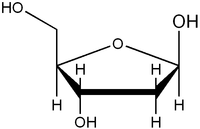Deoxyribose
|
|
Deoxyribose (more precisely 2-deoxyribose) is a five-carbon sugar (a pentose) derived from the pentose sugar ribose by the replacement of the hydroxyl group at the 2 position with hydrogen, leading to the net loss of an oxygen. Ribose forms a five member ring composed of four carbon atoms and one oxygen. Hydroxyl groups are attached to three of the carbons. The other carbon and a hydroxyl group are attached to one of the carbon atoms adjacent to the oxygen. In deoxyribose, the carbon furthest from the attached carbon is stripped of the oxygen atom in what would be a hydroxyl group in ribose. Sugars are members of a group of chemical compounds called carbohydrates.
Biological importance of Deoxyribose
Ribose and 2-deoxyribose derivatives have an important role in biology. Among the most important derivatives are those with phosphate groups attached at the 5 position. Mono, di, and triphosphate forms are important, as well as 3-5 cyclic monophosphates. There are also important diphosphate dimers called coenzymes that contain ribose, examples are NAD and FAD.
Aromatic bases called purines and pyrimidines form an important class of compounds with ribose and deoxyribose. When these purine and pyrimidine devivatives are coupled to a ribose sugar they are called nucleosides. In these compounds, the convention is to put a ′ (pronounced "prime") after the carbon numbers of the sugar, so that in nucleoside derivatives a name might include, for instance, the term "5′-monophosphate", meaning that the phosphate group is attached to the fifth carbon of the sugar, and not to the base. The bases are attached to the 1′ ribose carbon in the common nucleosides. Phosphorylated nucleosides are called nucleotides.
One of the common bases is adenine (a purine derivative), coupled to ribose it is called adenosine, coupled to deoxyribose it is called deoxyadenosine. The 5′-triphosphate derivative of adenosine, commonly called ATP, for adenosine triphosphate, is an important energy transport molecule in cells.
See nucleic acid nomenclature for a diagram showing the numbered positions in a 5′-monophosphate nucleotide.
2-deoxyribose and ribose nucleotides are often found in unbranched 5′-3′ polymers. In these structures the 3′ carbon of one monomer unit is linked to a phosphate that is attached to the 5′ carbon of the next unit, and so on. These polymer chains often contain many millions of monomer units. Since long polymers have physical properties distinctly different from small molecules they are called macromolecules. The sugar-phosphate-sugar chain is called the backbone of the polymer. One end of the backbone has a free 5′ phosphate and the other end has a free 3′ OH group. The backbone structure is independent of which particular bases are attached to the individual sugars.
Genetic material in earthly life often contains poly 5′-3′, 2′-deoxyribose nucleotides, in structures called chromosomes, where each monomer is one of the nucleotides deoxy- adenine, thymine, guanine or cytosine. This material is commonly called deoxyribonucleic acid, or simply DNA for short.
DNA in chromosomes forms very long helical structures containing two molecules with the backbones running in opposite directions on the outside of the helix and held together by hydrogen bonds between complementary nucleotide bases lying between the helical backbones. The lack of the 2′ hydroxyl group in DNA appears to allows the backbone the flexibility to assume the full conformation of the long double helix, which involves not only the basic helix, but additional coiling necessary to fit these very long molecules into the very small volume of a cell nucleus.
In contrast, very similar molecules, containing ribose instead of deoxyribose, and known generically as RNA, are only known to form relatively short double helical complementary base paired structures. These are well known, for instance, in ribosomal RNA molecules and in transfer RNA (tRNA), where so called hairpin structures form from palindromic sequences within one molecule.de:Desoxyribose es:desoxirribosa fr:Désoxyribose pl:Deoksyryboza

